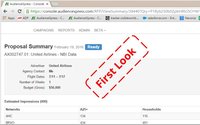 In a move that could greatly
accelerate the programmatic TV advertising marketplace, a major supply-side developer -- Comcast’s AudienceXpress unit -- has begun rolling out a self-serve platform enabling agencies to build
TV audience reach based on their campaign objectives.
In a move that could greatly
accelerate the programmatic TV advertising marketplace, a major supply-side developer -- Comcast’s AudienceXpress unit -- has begun rolling out a self-serve platform enabling agencies to build
TV audience reach based on their campaign objectives.
The interface, aptly named Pronto, is an important baby step in building a bridge between the supply and demand sides of the
burgeoning programmatic TV marketplace. Unlike online and mobile display and video markets, where the supply of inventory outpaced demand, the TV industry has been loath to embrace and adopt
programmatic technology giving agencies and brands direct access to their audience inventory.
Pronto is a baby step, because it gives agency planners and buyers all the controls of
assembling the audiences they want to reach, but enables suppliers -- primarily cable TV operators -- to control the supply of inventory, including how it is priced.
advertisement
advertisement
“In the
evolution of AudienceXpress, we started by automating inventory management and trafficking to make it easier for agencies and advertisers to buy,” explains President Walt Horstman, adding:
“As the business has expanded, we are now providing a more automated set of capabilities for agencies and advertisers.”
Pronto -- which is currently being beta tested by
a number of big agencies, which declined to talk on the record -- is in fact an evolution more than a revolution, which is part of the genius of AudienceXpress. That’s because the last thing the
TV industry is looking for is another revolution. And after observing the way programmatic technology and marketplaces disrupted the balance of power between the supply and demand sides, major TV
suppliers have been reluctant to lose control of their inventory.
By creating a new secondary marketplace for the TV industry to sell and giving it 100% control over supply, pricing
and timing, AudienceXpress has established a more balanced approach. Horstman cautioned that Pronto is still being tested and evaluated, but he says the results have been encouraging and that based on
initial feedback, it is likely it will be rolled out to the general marketplace early next year, enabling agencies and brands to log in and build their own audience schedules.
One of
the reasons it works so well for both sides is that agencies and brands do not get the price of “capacity” visibility into individual systems and networks participating in the platform,
just the aggregate delivery of the audiences they are assembling through it. Agencies and brands can fine-tune their schedules by removing specific suppliers -- networks they may need to
“blacklist” for their own campaign or brand sensitivity reasons -- and Pronto spits out aggregate schedules based on the audience composition they are targeting. Importantly, it does it
with the data -- first-, second- or third-party -- that the brands and agencies are using to build their campaigns.
Conversely, TV suppliers get 100% visibility into pricing, supply
and demand, so there is little risk for them to participate in AudienceXpress, and upside by creating demand through a secondary marketplace.
Importantly, AudienceXpress has begun
moving beyond its original model of aggregating local cable TV inventory controlled by cable and satellite operators to include local TV inventory from broadcasters. AudienceXpress parent Visible
World already has a deal with Sinclair Broadcast Group and is beginning to incorporate its inventory as a source for agencies and brands to build TV audience reach.
Based on current
testing, Horstman says Pronto should be available to the general marketplace by the second half of 2017 and that it will be a continuous process of testing and learning what happens as it gives more
control over the process to the demand side of the marketplace.
“We’ll take more and more off the training wheels off the system based on what we see is working,” he said,
adding, that as much as it wants to facilitate more demand, AudienceXpress will always remain a supply-side platform.